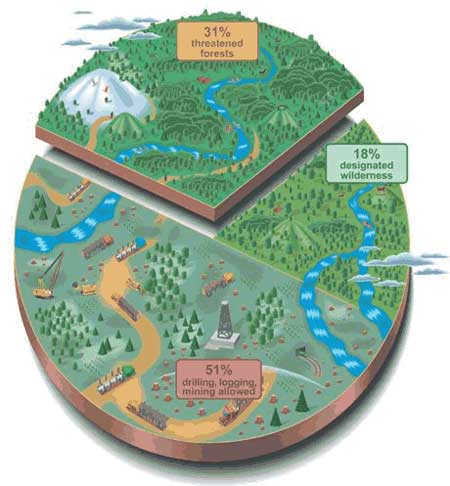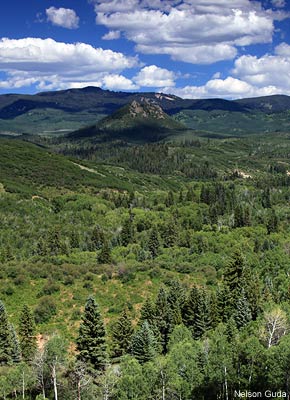Leasing Colorado's Legacy
The landmark Roadless Area Conservation Rule protects 58.5 million acres of America's national forests including 4.4 million in Colorado from new road-building associated with commercial logging and oil, gas and other industrial development. Issued by the Clinton administration in January 2001, it is a balanced environmental measure that does not close any existing roads or recreational trails, restrict access for private property owners, or interfere with existing leases or permits for mineral development or oil and gas operations. It also allows for new roads to be built to respond to fires and other natural disasters.

America's roadless policy has enjoyed widespread popularity since it was adopted, though timber and other extractive industries have made repeated attempts to undo it through a series of lawsuits and appeals intended to open up undeveloped areas. They succeeded in May 2005, when the Bush administration repealed the 2001 rule and replaced it with a complicated state-by-state process that required governors to petition the federal government if they wanted undeveloped national forests in their states to receive protection. But in September 2006, a federal court reinstated the original policy and it again became the law of the land. Despite the setback, the administration encouraged governors to file petitions under the Administrative Procedures Act. Of the 38 states in the nation that have national forest roadless areas, only Idaho and Colorado have participated in this process.
Despite the setback, the administration encouraged governors to file petitions under the Administrative Procedures Act. Of the 38 states in the nation that have national forest roadless areas, only Idaho and Colorado have participated in this process. Given continued legal wrangling, Colorado Governor Bill Ritter, a public supporter of the roadless rule, agreed in early 2006 to participate in state-based rulemaking as an “insurance policy” to protect Colorado’s 4.4 million acres of national forest backcountry.
However, more than two and one-half years later, the situation in the courts, in Washington and elsewhere in the West has changed dramatically, and this rulemaking has made Colorado vulnerable to new drilling for oil and gas in some of the state’s best backcountry. Consider the following:

- The Bush administration is using its final days in office to do what it has not been able to achieve during the previous seven and a half years: to repeal the roadless rule and replace it with a policy that would allow road-building and drilling in pristine areas of Colorado’s national forests currently off limits to such development.
- A little known loophole in the administration’s new proposal would allow roughly 100 new oil and gas projects to proceed in roadless areas in the Grand Mesa-Uncompaghre-Gunnison, White River, San Juan and other national forests. These new leases are in addition to those recently approved by the administration on the Roan Plateau and in other pristine areas of the state.
- The full impact of this industrial development on watersheds and valuable fish and wildlife habitats in these roadless areas has not been thoroughly assessed through a formal administrative process.
- The amount of oil and gas that could be practically taken from all Colorado’s national forest roadless areas represents a drop in the bucket of the country’s energy needs. Analyzing recent U.S. Geological Service data, The Wilderness Society found that at current energy consumption rates, the economically recoverable natural gas in all of Colorado’s roadless areas could meet total U.S. gas consumption for only 10 to 17 days. Similarly, economically recoverable oil in the state’s roadless areas would fuel less than 12 hours of total U.S. oil consumption.
- For the past two years, the roadless rule has remained the law of the land, and it is unlikely that the courts would issue a decision impacting its validity with regard to Colorado prior to 2009. Considering the current judicial climate, the need for a Colorado “insurance policy” appears increasingly unnecessary.
Ironically, the petition process endorsed by Governor Ritter to protect Colorado’s roadless areas from litigation and other challenges will result instead in singling out Colorado’s 4.4 million acres of backcountry forests as a target for future road-building and development, as they will be less protected than those in other states.
Governor Ritter can best serve Colorado and the nation by calling on the Bush administration to suspend its current rulemaking until there is a thorough assessment of the full impact of these new oil and gas leases on water quality, valuable fi sh and wildlife, outdoor recreation and the state’s economic future. This prudent and precautionary step is essential to maintaining the Governor’s balanced approach to energy development in the state. It also will ensure the preservation of Colorado’s last pristine forests as a legacy for future generations.
Because once they’re gone, they’re gone forever.






